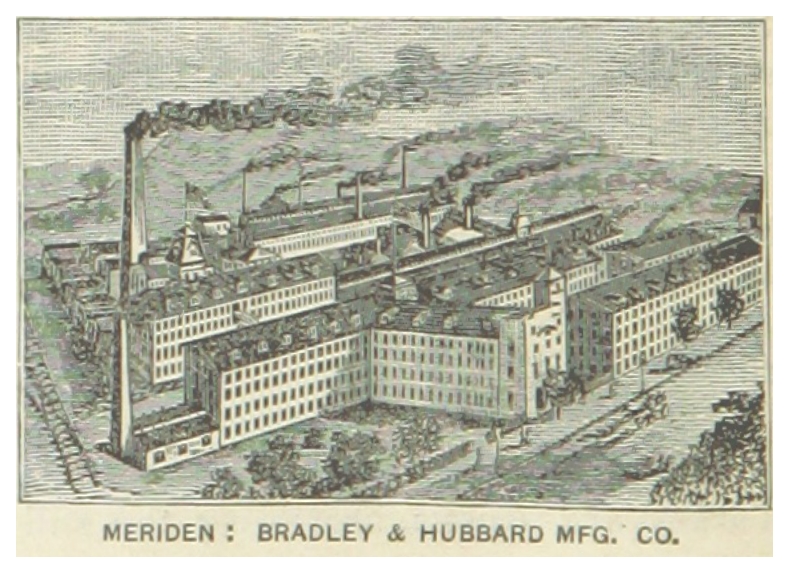By Christina Volpe
Once known internationally, Meriden’s Bradley & Hubbard Manufacturing Company was an industry-leading American manufacturer of kerosene lamps and metal household items—from clocks to match safes to stationery sets. The company’s roots date back to its founding in 1852 by Nathaniel and William Bradley of Southington and Walter Hubbard of Meriden.
Between 1856 and 1934, Bradley & Hubbard secured over two hundred patents aimed at enhancing the mechanics of their lamp designs. These innovations encompassed improvements in wick-raising mechanisms, oil level measurements, spillage prevention with metal ridges, and optimizing flame spreaders. Bradley & Hubbard’s legacy endured until 1940 when the Charles Parker Co.—a rival company from the same town—acquired their operations.
The Creation of Bradley & Hubbard
Nathaniel and William Bradley, Orson and Chitten Hatch, and Walter Hubbard initially co-founded the company in 1852. The Hatch brothers withdrew within two years, and the company transitioned to Bradley & Hubbard. While clocks dominated their initial offerings, they diversified their catalog in the 1860s to include match safes, call bells, urns, bookends, frames, desk accessories, and vases.
In 1862, Nathaniel Bradley and Walter Hubbard acquired William Bradley’s stake, then formed a joint stock company called The Bradley & Hubbard Manufacturing Company in 1875. From its modest beginnings, the factory expanded to seven acres, employing around 1,500 individuals. The company established salesrooms in major cities such as New York, Boston, Chicago, and Philadelphia—supported by a network of traveling sales associates.
By the late 19th century, Bradley & Hubbard began producing architectural grills for fireplaces, railings, fences, window guards, and elevator enclosures. They solidified their reputation in the 1890s by crafting high-quality, artistic pieces. Partnerships with retail giants such as Marshall Field & Company, Sears, Roebuck and Company, and Montgomery Ward & Company further elevated their prominence. Even the Great Depression failed to extinguish Bradley & Hubbard’s flame.
After 88 years of operation, however, Bradley & Hubbard changed hands; the Charles Parker Company, recognized for sporting shotguns and an array of household items, acquired the company in 1940. Post-acquisition, the Parker Company initiated the Bradley & Hubbard Division—intending to produce select legacy products, including bathroom accessories, lighting fixtures, architectural bronzes, and brass work—preserving Bradley & Hubbard’s legacy in a new era.
The Demise of Bradley & Hubbard Line
Within a year and a half after the acquisition, the United States entered World War II, prompting the Parker Company to focus on the war effort. The intensification of the conflict diverted most metal production to war-related goods, leaving little room for the Bradley & Hubbard line. By 1950, all references to the Bradley & Hubbard Division within the Parker Company’s literature vanished.
In 1976, in a somber turn of events, a raging fire engulfed the long-abandoned Bradley & Hubbard factory buildings. The loss was irreplaceable, as historical records that could have offered insights into the company’s past were either incinerated or buried under the ruins. Today, Bradley & Hubbard designs live on in numerous museums and collections around the country, including the Smithsonian and the Connecticut Museum of Culture and History.
Bradley & Hubbard is a testament to the ingenuity and resilience that shaped the nation’s history. From humble beginnings in Meriden, Connecticut, the company’s journey through time is marked by craftsmanship, evolution, and adaptability. Despite facing challenges such as fires, economic upheavals, and the tumult of war, Bradley & Hubbard left an indelible mark on the landscape of American manufacturing.
Christina Volpe is a public historian and Ph.D. Candidate at Salve Regina University. She holds an MA in public history from Central Connecticut State University where she focused on digital curation and historic preservation. Christina serves as curator of The Barnes Museum in Southington, Connecticut.












